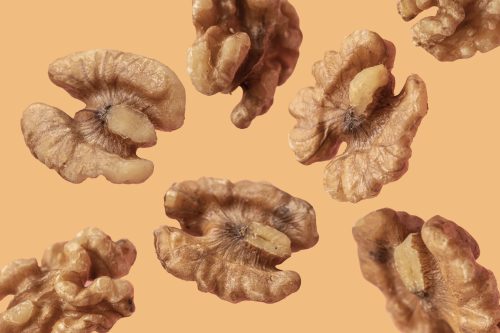Our editors independently select these products. Making a purchase through our links may earn Well+Good a commission
It’s Time To Stop Believing These 7 Myths About Endometriosis
The biggest? That your pain is normal.

This March is Endometriosis Awareness Month—a time to take a closer look at a largely misunderstood illness. Endometriosis is a chronic inflammatory condition in which endometrial-like tissue grows outside of the uterus, leading to symptoms like debilitating pain, menstrual irregularity, gut issues, and even infertility for some. The disease affects about 190 million women worldwide—myself included—but despite its prevalence, it's still a vastly underresearched and overlooked disease. In fact, it can take women up to 10 years or longer1 to receive a proper diagnosis, leaving many to feel unheard or frustrated with their healthcare providers and lack of treatment.
Experts in This Article
This was my exact experience during my 14-year diagnosis journey; multiple providers not only dismissed my very obvious symptoms but also shared wildly inaccurate information about the illness. But the spread of medical misinformation—both online and by healthcare professionals—can lead to collective misunderstanding (and even shaming) of endometriosis and many other conditions primarily affecting women.
Because it's difficult to separate fact from fiction when searching online, we've gathered the top seven endometriosis myths here, along with the truth behind each one, according to experts who study the condition every day. Read on to learn more.
7 myths to stop believing about endometriosis
Here are the top most common myths you might hear about endometriosis, and what the truth really is, according to experts.
Myth #1: It’s not hereditary
Turns out genes play a major role in endometriosis2, but not all providers acknowledge this fact. Case in point: My mom has endometriosis and when I brought this up to one of the many providers I'd seen over the years, they told me it was just a coincidence and that endo isn't heredity—but this is not true.
“Endometriosis is hereditary,” says Iris Kerin Orbuch, MD, author of Beating Endo: How to Reclaim Your Life from Endometriosis and founder of Iris Wings Sanctuary For Endometriosis Surgery & Wellness "So, if the mom or aunt or sister has endometriosis, then the daughter or niece or sibling has a 70 to 100 percent likelihood of having endometriosis.”
But it doesn't have to come from just your mom's side. Dr. Kerin Orbuch says the condition can be inherited from your dad's side, too, especially if his mother had endometriosis. Ultimately, if you have a uterus and someone you're biologically related to has endo, your chances of developing the condition are heightened, too.
Myth #2: It only flares up during your period
Because endometriosis is a whole-body condition, it can cause chronic pain regardless of where you are in your cycle. In other words, it's not just something that "flares during your period." The reality is that endometriosis lesions (i.e., patches of tissue) can grow on many other organs and muscles in the body, leading to debilitating pain and symptoms like gut issues, lower back pain, chronic fatigue, pain during sex, and bladder problems.
“Endometriosis traditionally causes pain during your period, but in many cases can cause pain prior to and/or after your period,” says Amanda Chu, MD, a board-certified minimally invasive gynecologic surgeon at Seckin Endometriosis Center (and one of the surgeons who performed my second endometriosis surgery). “Unfortunately, endometriosis can sometimes progress to where there is pain every single day.”
So, don’t let anyone dismiss your pain. If you’re experiencing symptoms that are disrupting your life in any way—whether it's during your period, before or after it, or even just randomly—it's worth bringing it up with a healthcare provider or getting a second opinion if they try to write it off as just a bad period.
“If your pain is causing you to not engage in those things you love, that’s too much pain,” Dr. Kerin Orbuch adds.
Myth #3: Only older women get endometriosis
There's a running narrative that endometriosis only affects older people, but the truth is that the condition does not discriminate by age. For example, I began feeling symptoms around my first period at 10 years old, and many other people with endo have similar stories. Preliminary research even suggests the possibility of endometriosis existing in the body well before puberty begins.
One study, in particular, examined the uteruses of 13 fetuses and found endometriosis present in one of them3. Another study from 2012 found that out of 101 fetuses examined, 9 percent of them had endometriosis4, leading researchers to theorize that endometriosis begins during organogenesis (i.e., during the development of the embryo).
On the flip side, people going through menopause and post-menopause can also develop endometriosis5, further emphasizing the fact that the growth of endometrial tissue outside of the uterus can happen at any age.
Myth #4: Birth control is your best option
While some medical professionals default to hormonal birth control as a way to manage endometriosis, it is not always the best option for everyone. "Birth control can be part of appropriate medical treatment for endometriosis, but endometriosis care is complex," says Dr. Chu.
"From a symptom standpoint, birth control may lessen heavy bleeding if someone is soaking through pads or tampons, or it may lessen their pelvic pain or painful periods," says Dr. Kerin Orbuch. "But that is just treating symptoms while the disease progresses," she adds. In other words, the pill can help manage symptoms like painful periods and a heavy flow, but it is not a cure. Birth control merely serves as a bandaid, and for people like me with other medical conditions that negatively interact with hormones, it isn't even an option at all.
This is why I've coined the term "endovidual" to describe people with endometriosis—it's a highly individualized condition which means there's no one-size-fits-all treatment.
Myth #5: Surgery should be a last resort
As of now, the gold standard for diagnosing endometriosis is laparoscopic surgery and removal of the lesions, (i.e., where the surgeon removes as much of the abnormal tissue as possible). This is because there is no other way for providers to definitively diagnose the condition without actually seeing the lesions.
“Although imaging such as MRI or specialized ultrasounds is highly sensitive for advanced endometriosis, early endometriosis is nearly always missed as it cannot currently be detected aside from clinical presentation,” says Dr. Chu. “Researchers are working on less invasive methods such as via blood or menstrual blood6, but until then, laparoscopic surgery can help to diagnose and treat endometriosis.”
Of course, surgery isn't the only step. As Dr. Kerin Orbuch explains, a good approach is to do a whole-body assessment to identify and address other factors that might be contributing to your pain. This might involve physical therapy for tight muscles, dietary changes for gut issues, or treatment for bladder problems.
“We always want to try non-invasive options first to undo the other things that are causing pain that the decade-long diagnostic delay of endometriosis has caused,” says Dr. Kerin Orbuch. “If patients have tight muscles because of their endo, I’ll send them to get tested for SIBO (small intestinal bacterial overgrowth), or if they have concomitant painful bladder syndrome or interstitial cystitis, I’ll treat that by putting them on a low acid, low potassium diet—but none of those treat endometriosis.”
In my own experience leading up to my second surgery, I had at least six imaging appointments, several ultrasounds, and a round of medical visits with various specialists. This was to make sure nothing else was going on and to provide as much information as possible to the surgeon so there wouldn’t be any surprises when I went under the knife.
“You don’t want to wait too long before you operate because then you have to spend more time, energy, and resources on undoing all of the other pain generators that have been put into place as well as the longer-standing inflammation that is arising from the endometriosis implants,” adds Dr. Kerin Orbuch.
Myth #6: Bladder issues and endometriosis aren’t linked
This myth may be niche depending on your symptoms, but for me, interstitial cystitis (IC)—a chronic bladder condition characterized by pelvic discomfort, pain, or pressure—has been a major complication of my endometriosis. “Those with endometriosis have roughly 52 to 92 percent likelihood of also having concomitant interstitial cystitis,” says Dr. Kerin Orbuch. This is why IC is also referred to as "endo’s evil twin," she adds.
So, if you're ever dealing with trouble peeing, urgency, or bladder pain along with endo symptoms, just know that the two could be inextricably linked. According to Dr. Chu, IC is diagnosed through exclusion, meaning specialists rule out other conditions that could be causing bladder pain first, like a urinary tract infection (UTI), for instance.
It's also possible to have endometriosis lesions grow on your bladder (similarly to the bowel), so Dr. Chu says to make sure endo is properly ruled out before simply assuming it's just a bladder issue. "This often happens with the gut, and you're labeled as just having IBS!" she adds.
Myth# 7: Pain is normal
The pain felt with endometriosis stretches above and beyond a period cramp, so it's a myth that this pain is "just part of being a woman" and that we have to "grit and bear it." Studies have found that endometriosis pain is so severe that more than one-quarter of women7 who have it miss work or school8 at least one day per six months because of it. And according to the UK's National Health Service, it's one of the 20 most painful health conditions a person can have.
All this to say, living with continuous, debilitating pain is not normal—no matter what certain healthcare providers may tell you. "Your pain is real," says Dr. Kerin Orbuch. "I always want women to know that I believe their pain."
If you feel as though your provider isn't hearing you, it's okay to find someone new—especially someone well-versed in endometriosis research and treatment advancements.
How to be your best advocate at the doctor (and why it’s important)
Because endometriosis is an overlooked and misunderstood disease, it's important to be your own best advocate when dealing with the condition. I went to seven healthcare professionals before finally receiving my diagnosis, even though I knew I had endo the whole time based on my symptoms and family history.
Eventually, I found specialists who listened to my concerns and performed laparoscopic and excision surgery to help me heal. Here's what I learned in the process of finding them about advocating for the care you need:
- If your provider won't take you seriously, find one who will. Because medical gaslighting is rampant, getting a second opinion for a health concern isn't always easy. If you see a provider that dismisses you or feels "off," trust your instincts and start the search for someone else.
- Thoroughly research your specialist. If you happen to find an endometriosis specialist to visit, be sure to read their online reviews before filling out the new patient paperwork. That way, you can get a sense of the type of care they provide. (Reddit is a great place to start.) Also, search for the term "excision" on their website or credentials section, which often means they are able to perform surgery if needed.
- Keep a pain journal. This might seem like adding insult to injury, but documenting your symptoms, triggers, and quality-of-life impact over time can help your provider see the bigger picture. You can find endo-specific pain tracking journals on Etsy ($13), make your own on Canva, or simply take notes on your phone or in a journal ($24).
- Bring a list of questions to your appointment. Try to go into your first specialist appointment confidently and be ready to ask questions. Remember it's okay to push back if they give you vague answers or instructions. Be sure to ask any clarifying questions you have, like whether they specialize in endometriosis (if you don't already know), what the benefits and risks of their proposed treatment plan are, and whether any follow-up care will be needed.
- Remember, you’ll likely need a healthcare team. My endometriosis care team includes two surgeons, one urologist, and my gynecologist. Depending on your symptoms, you may also need a gastroenterologist, physical therapist, dietitian, and/or mental health professional as part of your specialized care. The more support you have, the better. (More on this below.)
- Find a support group or online community. Having a support system, even if it’s with people online, is so important. Endometriosis is a really hard condition to go through alone. Find at least one person who will actively listen to you—a close, friend, family member, therapist, or even someone from an online support group.
The bottom line
Endometriosis is a really difficult condition to live with, diagnose, and treat. Deciphering fact from fiction when it comes to the disease is crucial so you can get the quality care you deserve. If you're ever unsure about whether a specific health issue is a result of endometriosis or not, reach out to a trusted healthcare provider who can point you in the right direction and help you get to feeling better.
- Frankel, Lexi R. “A 10-Year Journey to Diagnosis With Endometriosis: An Autobiographical Case Report.” Cureus vol. 14,1 e21329. 17 Jan. 2022, doi:10.7759/cureus.21329 ↩︎
- Chiorean, Diana Maria et al. “New Insights into Genetics of Endometriosis-A Comprehensive Literature Review.” Diagnostics (Basel, Switzerland) vol. 13,13 2265. 4 Jul. 2023, doi:10.3390/diagnostics13132265 ↩︎
- Signorile, P. G., Baldi, F., Bussani, R., D’Armiento, M., De Falco, M., Boccellino, M., Quagliuolo, L., & Baldi, A. (2010). New evidence of the presence of endometriosis in the human fetus. Reproductive BioMedicine Online, 21(1), 142–147. https://doi.org/10.1016/j.rbmo.2010.04.002
↩︎ - Signorile, P. G., Baldi, F., Bussani, R., Viceconte, R., Bulzomi, P., D’Armiento, M., D’Avino, A., & Baldi, A. (2012). Embryologic origin of endometriosis: Analysis of 101 human female fetuses. Journal of Cellular Physiology, 227(4), 1653–1656. https://doi.org/10.1002/jcp.22888
↩︎ - Jakson, I., Hirschberg, A. L., & Gidlöf, S. B. (2023). Endometriosis and menopause—management strategies based on clinical scenarios. Acta Obstetricia et Gynecologica Scandinavica, 102(10), 1323–1328. https://doi.org/10.1111/aogs.14583
↩︎ - Schoeman, E. M., Bringans, S., Peters, K., Casey, T., Andronis, C., Chen, L., Duong, M., Girling, J. E., Healey, M., Boughton, B. A., Ismail, D., Ito, J., Laming, C., Lim, H., Mead, M., Raju, M., Tan, P., Lipscombe, R., Holdsworth-Carson, S., & Rogers, P. A. (2024). Identification of plasma protein biomarkers for endometriosis and the development of statistical models for disease diagnosis. Human Reproduction, 40(2), 270–279. https://doi.org/10.1093/humrep/deae278
↩︎ - Yoshino, O., Takahashi, N. & Suzukamo, Y. Menstrual Symptoms, Health-Related Quality of Life, and Work Productivity in Japanese Women with Dysmenorrhea Receiving Different Treatments: Prospective Observational Study. Adv Ther 39, 2562–2577 (2022). https://doi.org/10.1007/s12325-022-02118-0 ↩︎
- Gupta, Jhumka et al. “Life Disruptions, Symptoms Suggestive of Endometriosis, and Anticipated Stigma Among College Students in the United States.” Women's health reports (New Rochelle, N.Y.) vol. 2,1 633-642. 27 Dec. 2021, doi:10.1089/whr.2021.0072 ↩︎










